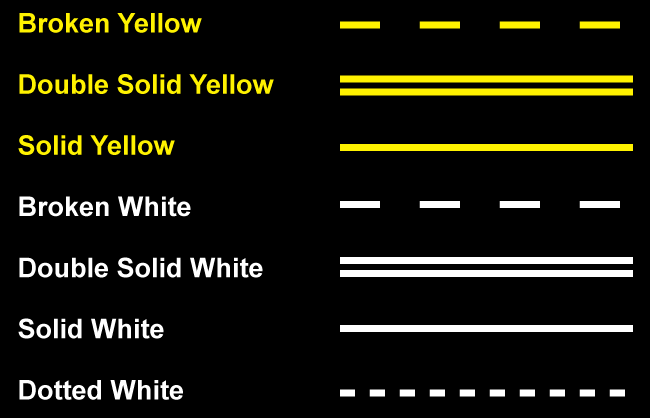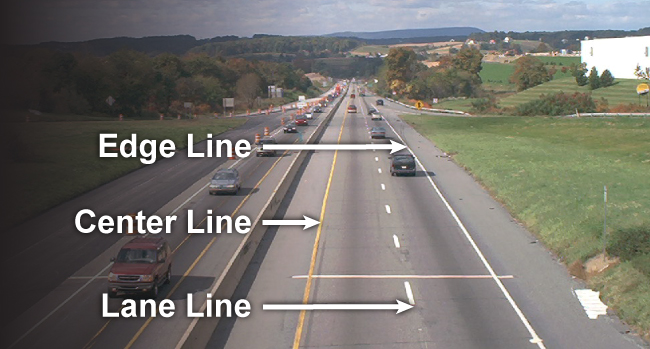Longitudinal Markings

Typical longitudinal markings include centerlines (yellow in color), lane lines (white in color), and edge lines (white or yellow in color). The chief advantage of longitudinal pavement markings is that they provide continuous guidance. Longitudinal markings are the primary source of information for positioning vehicles on the roadway. Broken lines should consist of 10-foot line segments and 30-foot gaps, or dimensions in a similar ratio of line segments to gaps as appropriate for traffic speeds and need for delineation. A dotted line for line extensions within an intersection or taper area should consist of 2-foot line segments and 2- to 6-foot gaps. A dotted line used as a lane line should consist of 3-foot line segments and 9-foot gaps.
Yellow Lines: delineate the separation of traffic flows in opposing directions, or mark the left edge of the pavement of divided highways and one-way roads.
White Lines: delineate the separation of traffic flows in the same direction, or mark the right edge of the pavement.
Longitudinal Marking Warrants
Center line pavement markings are used to delineate the separation of traffic lanes that have opposite directions of travel on a roadway & shall be yellow in color. The MUTCD has established warrants for the use of various longitudinal markings. As shown below, center line markings are required on all paved urban arterials and collectors with a width of 20 feet or more and a width of 6,000 vehicles per day or greater; or on all paved two-way streets or highways having three or more traffic lanes. There are also other conditions where they should be used.
Lane lines are used to delineate the separation of traffic lanes used for travel in the same direction. They are required on all freeways and interstate highways, and are recommended on any roadway with two or more travel lanes per direction. Lane lines shall be white in color.
Edge lines delineate the right or left edges of travel way. Right edge lines shall be white in color. Left edge lines are generally used on one-way streets, divided highways, or on ramps. Left edge lines shall be yellow in color. Edge lines are required on all freeways and interstate highways, paved rural arterials with a travel width of 20 feet or more and an ADT of 6,000 vehicles per day or greater. They are recommended on paved rural arterials with a travel width of 20 feet or more and an ADT of 3,000 vehicles per day or greater, or where an engineering study indicates the need for an edge line.
Type |
Required |
Recommended |
| Center Lines |
- On all paved urban arterials and collectors that have a travel width of 20 feet or more and an ADT of 6,000 vehicles or greater
- On all paved two-way roads with three or more traffic lanes
|
- On paved urban arterials and collectors that have a travel width of 20 feet or more and an ADT of 4,000 vehicles or greater
- On all paved rural arterials or collectors with a travel width of 18 feet or more and an ADT volume of 3,000 or greater
- On other roads where an engineering study indicates a need
|
| Lane Line |
- On all freeways and Interstate highways
|
- On all roads with two or more travel lanes in the same direction
|
| Edge Line |
- On all freeways and expressways
- On all paved rural arterials with a travel width of 20 feet or more and an ADT of 6,000 vehicles or greater
|
- On all paved rural arterials and collectors with a travel width of 20 feet or more and an ADT of 3,000 vehicles or greater
- On other paved streets and highways where an engineering study indicates a need for edge lines
|



